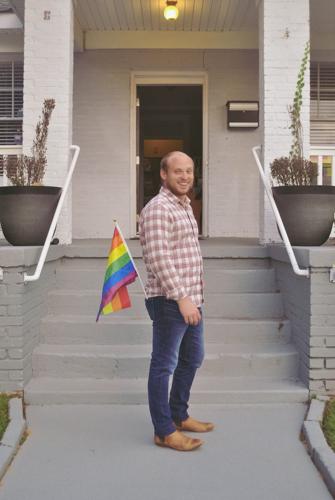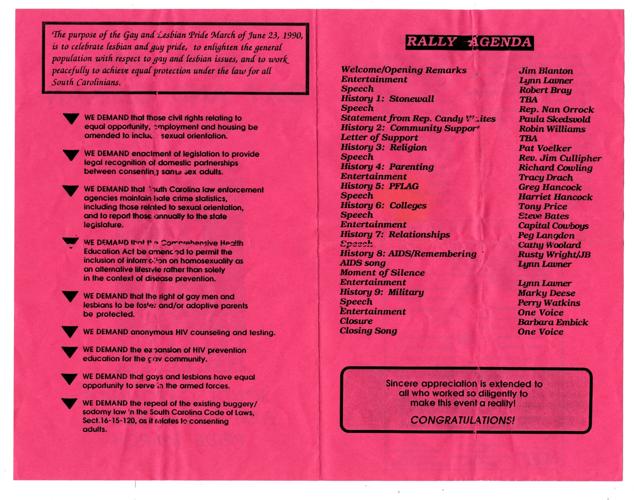When Harriet Hancock joined hands with her son at the first Pride on Main Street in Columbia, it set off a chain reaction of LGBTQ+ awareness across the state.
The 1990 march marked a milestone in a journey which began nearly a decade prior, when Hancock’s son, Greg, came out to her while studying at USC. She saw how Greg's friends’ parents struggled to accept their queer children and decided to do something to change this.
One day in 1982, Hancock was driving home listening to the radio. It was a call-in show, she recalled, and a woman was on the line talking about a group she started for parents of gays and lesbians in New York.
“I drove home as quickly as I could, jumped out of the car, and ran to dial the phone number,” Hancock told Free Times. “And they let me talk on air to the woman.”

Harriet Hancock is one of the architects of SC Pride and the namesake of the Hancock Center. (Photo by Eden Prime/Special to the Post & Courier)
The woman in question turned out to be Amy Ashworth, the mother of two gay sons in New York City. After founding the first southern chapter of PFLAG (Parents, Families and Friends of Lesbians and Gays) in late 1982 under the guidance of Ashworth, Hancock's activism led her to become an attorney. She proceeded to work tirelessly for the rights of the LGBTQ+ community in South Carolina.
“There’s a lot to still fight for, there's still a lot of discrimination,” Hancock reflected. “So it's not over yet. And it's not gonna be over for a long time …there's still a need for organizations and places like the community center.”
Along with other LGBTQ+ activists in Columbia, Hancock made major inroads in the 1990s for the social acceptance and legal rights of the community. Other groups adjacent to her efforts in allyship sprung up: Palmetto AIDS Life Support Services (PALSS) and South Carolina Pride (SC Pride), as well as affirming churches and healthcare providers.

The first-ever SC Pride March took place in 1990 as a way to increase visibility of Columbia's queer community (Photo provided by USC/Historic Columbia)
The Harriet Hancock Center Foundation was officially recognized in 1987 and has since provided many kinds of support to LGBTQ+ community in Columbia. On any given day, the center boasts a welcoming group of volunteers (allies and queer folks alike) – all eager to provide resources, advocate and create a welcoming space.
Matt Butler has served as leader at the Hancock Center since 2015. Originally, he was hired part-time to manage operations and fundraising, and more recently was named president of the board of directors.
When Butler came to Columbia as a USC student in 2001 and attended his first SC Pride in Finlay Park five years later, he stepped into a “bubble” of familial solidarity. But legislation in Columbia has changed since the 1990s to protect the LGBTQIA+ community from public discrimination, Butler noted.
“It used to be kind of a joke that there were more gay bars in Columbia than there were in Charlotte,” he laughed. “It speaks to the resilience of the community — it's been a place where we can be … there’s something to be said about the community and our allies here.”

Scenes from the Harriet Hancock Center (Photos by Jared Johnson/Special to the Post & Courier)
While the number of gathering spaces has waxed and waned over the years, Columbia still serves as an epicenter for queer life in South Carolina. The capital city is home to an active assemblage of LGBTQ+ organizations, often working in close partnership with one another to meet community needs.
In 2023, SC Pride underwent a turnover in leadership, and moved back into the Hancock Center House for the first time in over a decade. This change breathed new life into the group’s ties with the center.
“I see in their board a renewed desire to move forward as one group and build relationships in the community,” Butler said, referring to SC Pride, “It's going to be intentional and intersectional. There’s challenges we are facing as a community, and it's important to get people on the same page.”
The first SC Pride
The first SC Pride March grew out of an annual picnic that was hosted at Dreher Island State park. In 1989, Hancock, along with Jim Blanton and Barbara Embick, fielded the picnic attendees’ interest in marching publicly down Main Street. It took a year to plan, but it finally happened in 1990.

Dylan Gunnells, interim president of SC Pride, at the Harriet Hancock Center. (Photos by Jared Johnson/Special to the Post & Courier)
Josh Butler, Marketing Director for SC Pride, grew up in the rural Ballentine area feeling isolated from the LGBTQ+ community that he craved.
“I grew up thinking I was the only gay person that had these types of feelings even though, not 20 minutes down the road, there was a whole metropolis,” he recollected.
SC Pride is stepping out with a renewed vision for a future that will hopefully include the rural parts of the state.

The first-ever SC Pride March took place in 1990 as a way to increase visibility of Columbia's queer community (Photo provided by USC/Historic Columbia)
Butler described the SC Pride Board’s hope to see people inspired by the efforts made to keep the LGBTQ+ community in Columbia safe and visible, and bring allyship and solidarity to their towns and neighborhoods.
“What I believe, when it comes to South Carolina Pride, is that we were the first step into bringing more visibility,” Butler mused. “And we're still stepping – we're just asking people to step with us. That's all it is.”
Black Pride meets the needs of the community
For over 35 years, dynamic organizations have arisen to meet the needs of queer South Carolinians. Other major cities followed Columbia’s lead, producing organizations like Upstate Pride and Upstate Black Pride in the Upstate, and The Alliance for Full Acceptance in Charleston, among others. Each organization plays a unique role in elevating and caring for different parts of the diverse LGBTQ+ population in South Carolina.
South Carolina Black Pride entered the scene officially in 2005, springing from a Black-lead committee of community leaders who came together in 2001. Darius Jones, the President of SC Black Pride, joined the leadership team in 2009 while attending Allen University.
Jones reached out to Dr. Todd Shaw, the founding president of SC Black Pride, and offered to help rebuild the organization’s website. Little did he know that this would be the start of a career in leadership and activism.

Darius Jones, CEO of SC Black Pride
“I asked to redo their website for free,” remembered Jones, adding that Dr. Shaw reached out to set up a meeting with Jones. "I didn’t know he had looked me up, and he had a plan for me.”
Today, SC Black Pride is a bustling center for activism in the city, not only serving the Black, queer Columbia population but making headway in equity activism by partnering with the Center for Black Equity in Washington, DC.
SC Black Pride hosts Black Pride Week celebrations annually in August. The group also co-hosts events such as candidate forums during election season and monthly ladies’ mixers at the Hancock Center.
“We want to keep having fun and celebrate what it is to be gay and Black in South Carolina,” Jones said. “And stand against the struggle of what it is to hold those identities in this space.”
Solidarity is key
Solidarity between activists, allies and LGBTQ+ community members is key to making headway both socially and legislatively.
“Harriet added people from the straight community, who advocate for the LGBT portion of the community,” Andrew Morrison pointed out. “And now it’s the lesbian and gay portion of the community’s job to advocate for the trans community.”
Morrison is the Treasurer of the board at the Hancock Center and a supporter of collaboration between advocacy organizations in Columbia.

Adult gay fiction books for sale at All Good Books in Five Points. (Photos by Jared Johnson/Special to the Post & Courier)
Working to make LGBTQ+ activism and allyship a family affair is what Hancock’s efforts were focused on, and the current leadership at the Hancock Center continues to uphold this vision.
“The thing that we bring to the Pride celebration is the family area,” added Morrison. The Hancock Center partnered with Richland Library for past Prides to give away books and host face painting and balloon animals.
Businesses and community hubs, like the library, offer a visible demonstration of queer solidarity in action. Ruth Samryl, the manager of All Good Books on Harden Street, is a veteran of quiet and determined activism.
“I go to great lengths to put pride tables up in [All Good Books] and have gay writers on end caps,” Samryl said, reflecting on her subtle touches in the retail space. “I do my best to get them on there. The quiet people often kind of go unnoticed, but it's the quiet people who make the inroads to get where they need to be.”

Dylan Gunnells, interim president of SC Pride, walks up the steps of the Harriet Hancock Center. (Photos by Jared Johnson/Special to the Post & Courier)
It takes all kinds of approaches to make activism happen, and Columbia has no shortage of diverse strategies to help the LGBTQ+ community be heard, seen and protected.
With an entourage of nonprofits, businesses, affinity groups and individual community organizers working together, there is no end in sight to innovation possible. Columbia remains at the center of the effort for LGBTQ+ liberties in South Carolina, yet the ultimate vision remains to broaden the “bubble” of visibility and safety to the rest of the state.
“There's an opportunity for Columbia folks to pick up the mantle and try to spread these privileges to the rest of the state,” The Hancock Center's Matt Butler concluded.
















